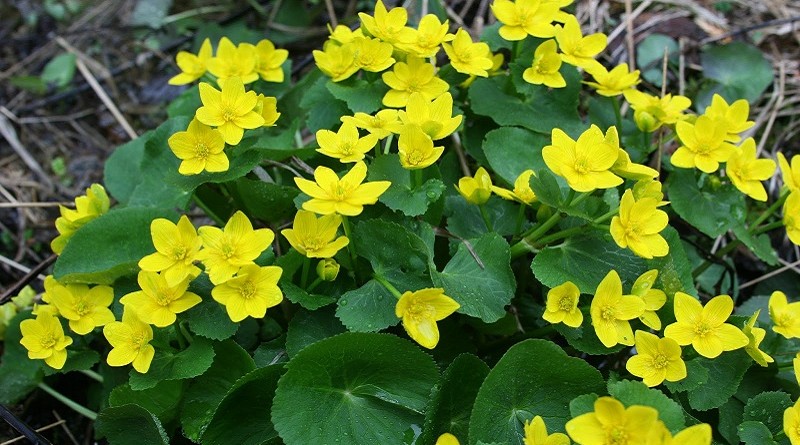Spring is time for Pure Michigan Blossoms
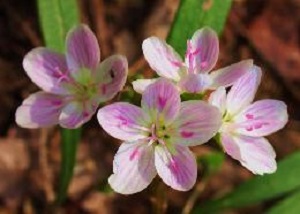 As the winter snow melts away, spring wildflowers begin to push their way up through the ground to welcome the new warm-weather season. Located in the heart of the Great Lakes region, Michigan is home to approximately 1700 native wildflower species of all shapes and sizes, found from coast to coast to coast.
As the winter snow melts away, spring wildflowers begin to push their way up through the ground to welcome the new warm-weather season. Located in the heart of the Great Lakes region, Michigan is home to approximately 1700 native wildflower species of all shapes and sizes, found from coast to coast to coast.
My love of nature – flowers, trees and birds – comes from my maternal grandmother who helped me in high school with various biology class projects such as my leaf and bug collections. Thanks to grandma, I’ve remained fascinated as an adult by birds (specifically cardinals), trees (birch and gingko) and flowers (lilacs)…but, ironically, not bugs!
While all gardens and flowers are beautiful, I’ve been drawn to the natural formation of wildflowers as they grow along the side of the roads as I travel Michigan. The variety of colors, textures and sizes I think make the prettiest impact.
According to the Michigan Department of Natural Resources, “all plants are protected on Michigan’s public lands, including road rights-of-ways. Additionally, 243 native plants are listed as threatened or endangered and are protected by Michigan’s Endangered Species Act.
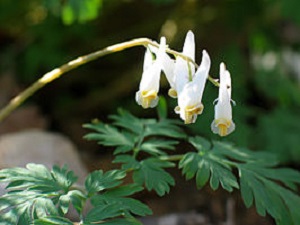 The wetlands and woodlands present the first displays each spring – when marsh marigold, wild garlic, jackin-the-pulpit, bloodroot, trillium and Dutchman’s breeches make their showing. Blossoms can also be found throughout the summer in the dunelands, meadows, stream banks, shorelines and rocky slopes along the highways and byways.
The wetlands and woodlands present the first displays each spring – when marsh marigold, wild garlic, jackin-the-pulpit, bloodroot, trillium and Dutchman’s breeches make their showing. Blossoms can also be found throughout the summer in the dunelands, meadows, stream banks, shorelines and rocky slopes along the highways and byways.
To learn more about Michigan’s wildflowers, download the DNR’s Michigan Wildflower Viewing Guide.
Founded in 1986, the Wildflower Association of Michigan encourages the preservation and restoration of Michigan’s native plants and native plant communities.
“Michigan’s native plants and plant communities are part of our natural heritage and should be preserved for future generations,” the WAM reports on its website. “By one estimate, 25 percent of Michigan’s plants will be extinct by 2050, as the result of loss of habitat due to development and invasion by aggressive non-native plants—and this estimate doesn’t include the possible effects of global warming. By cultivating native plants in your yard, you can help preserve the existing diversity of native vegetation and wildlife.”
The association also reports that:
- native plants are easy to grow and maintain because they, unlike plants from Europe and Asia and even from other regions of our own continent, are well adapted to our soils and climate, with its extremes of weather;
- native plants provide food and shelter for the wildlife with which they have evolved over millennia, and recent research is showing that the support for wildlife provided by native vegetation is better than that offered by non-native plants;
- landscaping with native plants not only lowers water use—it improves water quality;
- landscaping with native plants helps reduce global warming as many of our native plants are able to store carbon in their deep and extensive root systems, thus permanently removing it from the air.
The Michigan Nature Association is a nonprofit conservation organization working to protect Michigan’s rare, threatened and endangered species by protecting the lands and waters they need to survive. Established in 1952, MNA’s members, donors, and volunteers have built a remarkable network of more than 170 nature sanctuaries across the state – the largest network of natural areas established and maintained by a nonprofit conservation organization in Michigan. Through the help of staff, volunteers, members and donors, MNA protects more than 10,000 acres of Michigan’s most special natural areas and stewardship of more than 170 nature sanctuaries and plant preserves in nearly 60 counties around the state.
The Loda Lake National Wildflower Sanctuary is located in the heart of the Huron-Manistee National Forests in Baldwin. It is the only wildflower sanctuary in the National Forest System, a project supported both financially and botanically by the Federated Garden Clubs of Michigan for over 70 years.
“Loda Lake is ideally suited as a wildflower sanctuary and although near one of Michigan’s busy highways, can still be a natural reservoir of wild plants,” says botanist Clayton Bazuin. “This is due to the large number of ecological associations it affords in which they may survive.”
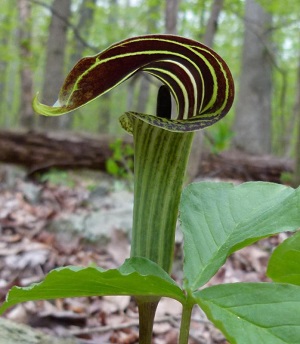 The property includes a small spring-fed lake, a bog-like wetland area, a creek and marshy areas as well as an oak forest, pine plantations and an early successional old farm site. There are more than 200 wildflower species (and over 500 unique plant species) found at Loda Lake.
The property includes a small spring-fed lake, a bog-like wetland area, a creek and marshy areas as well as an oak forest, pine plantations and an early successional old farm site. There are more than 200 wildflower species (and over 500 unique plant species) found at Loda Lake.
Aldo Leopold (1887-1948) was an American scientist, ecologist, forester, environmentalist, conservationist and author of A Sand County Almanac (which was published posthumously in 1949 and has sold more than two million copies). He was also a professor at the University of Wisconsin and was influential in the development of modern environmental ethics and in the movement for wilderness conservation.
Born and raised in Wisconsin, the Leopold family vacationed in the forested Les Cheneaux Islands in northern Lake Huron, near the cities of Cedarville and Hessel in Michigan’s Upper Peninsula. The area was a natural playground for young Aldo, who took to exploring the woods and waters—which shaped his future. Aldo’s legacy has taken root in the Les Cheneaux area, with the establishment of a nearly 1700-acre nature preserve on Marquette Island which bears his name (and is maintained by the Little Traverse Conservancy). The Aldo Leopold Festival is also planned for May 13-15, with this year’s theme: “Celebrating the North Huron Birding Trail.”
Michigan is home to one chapter of The Nature Conservancy—a global organization that works in 69 countries worldwide and all 50 states. In Michigan, this group hosts countless events and maintains about 20 preserves throughout both the Upper and Lower Peninsulas.
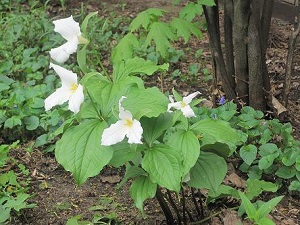 Michigan is also home to several local, grass-roots organized conservancies, including:
Michigan is also home to several local, grass-roots organized conservancies, including:
- Cadillac Area Land Conservancy
- Chippewa Watershed Conservancy
- Grand Traverse Regional Land Conservancy
- Gratiot Lake Conservancy
- Grosse Ile Nature & Land Conservancy
- HeadWaters Land Conservancy
- Land Conservancy of West Michigan
- Leelanau Conservancy
- Legacy Land Conservancy
- Little Forks Conservancy
- Little Traverse Conservancy Land Trust
- Michigan Karst Conservancy
- Mid-Michigan Land Conservancy
- North Woods Conservancy
- Saginaw Basin Land Conservancy
- Six Rivers Regional Land Conservancy
- Southeast Michigan Land Conservancy
- Southwest Michigan Land Conservancy
- U. P. Land Conservancy
- Yellow Dog Watershed Preserve
Other Michigan eco-friendly organizations can be found here.
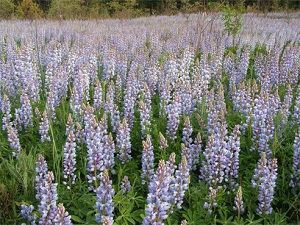 Looking to add a natural garden to your property? The Michigan Wildflower Farm, located in Ionia County, is a working farm open for visitation by appointment only. Open since 1988, they produce native Michigan wildflower and grass seed—most of which is collected from within a 150-mile radius of the farm. Seeds are sold through mail order, telephone, email and fax. They also specialize in installation and management of rain gardens, shoreline restorations, detention and retention basins, bio-swales, wetland mitigations, CRP and SAFE projects, meadows, prairies and gardens. They work with businesses, housing developments, libraries, municipal offices and single homes in urban and rural settings throughout Michigan.
Looking to add a natural garden to your property? The Michigan Wildflower Farm, located in Ionia County, is a working farm open for visitation by appointment only. Open since 1988, they produce native Michigan wildflower and grass seed—most of which is collected from within a 150-mile radius of the farm. Seeds are sold through mail order, telephone, email and fax. They also specialize in installation and management of rain gardens, shoreline restorations, detention and retention basins, bio-swales, wetland mitigations, CRP and SAFE projects, meadows, prairies and gardens. They work with businesses, housing developments, libraries, municipal offices and single homes in urban and rural settings throughout Michigan.
As you travel around Pure Michigan in search of wildflowers, be sure to check out Michigan.org for a list of events, lodging properties, attractions, restaurants and more.

Safe Travels!


